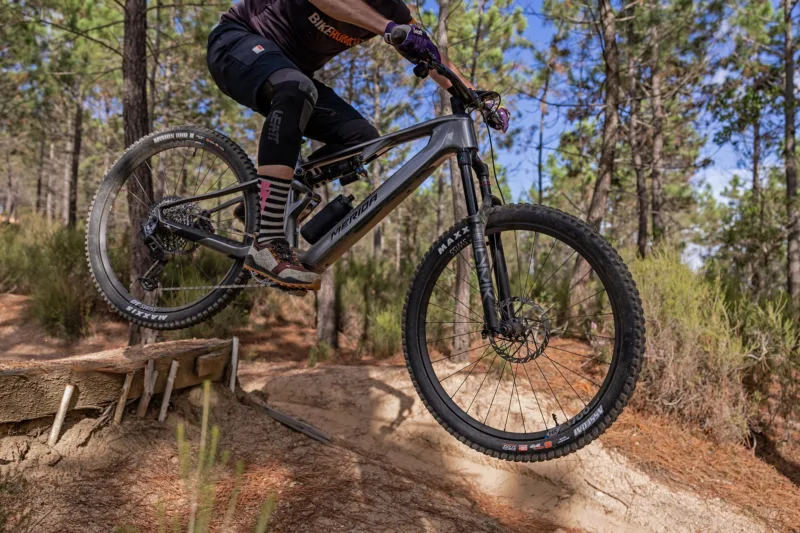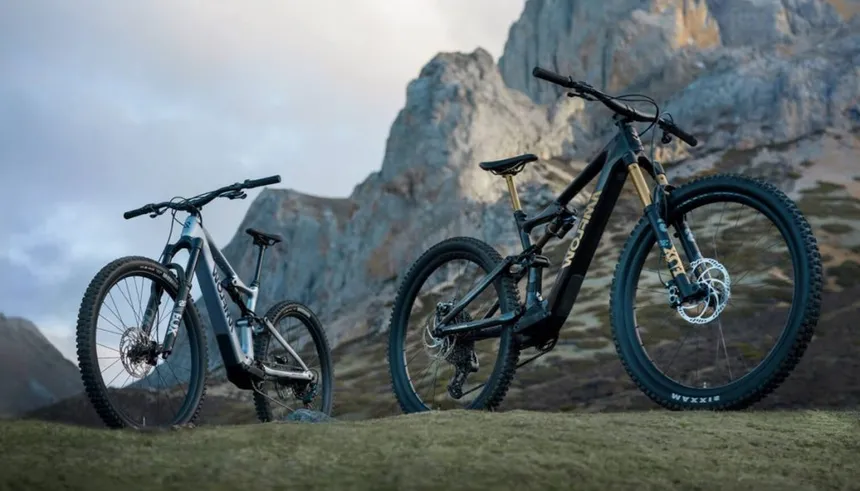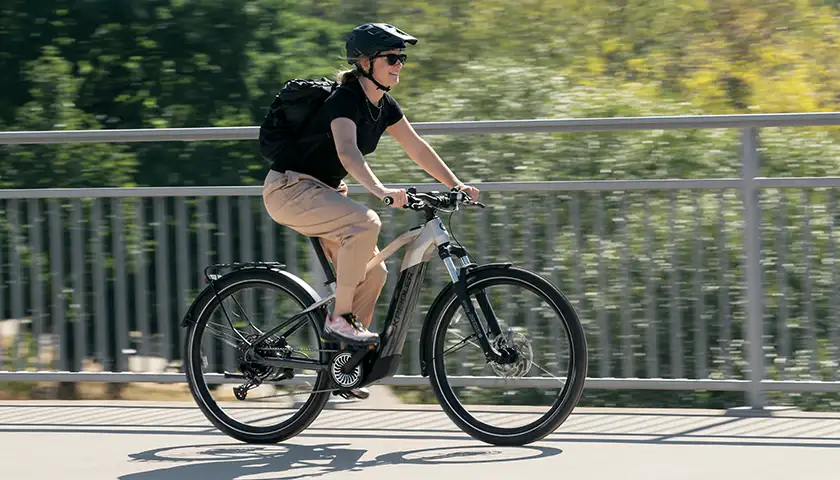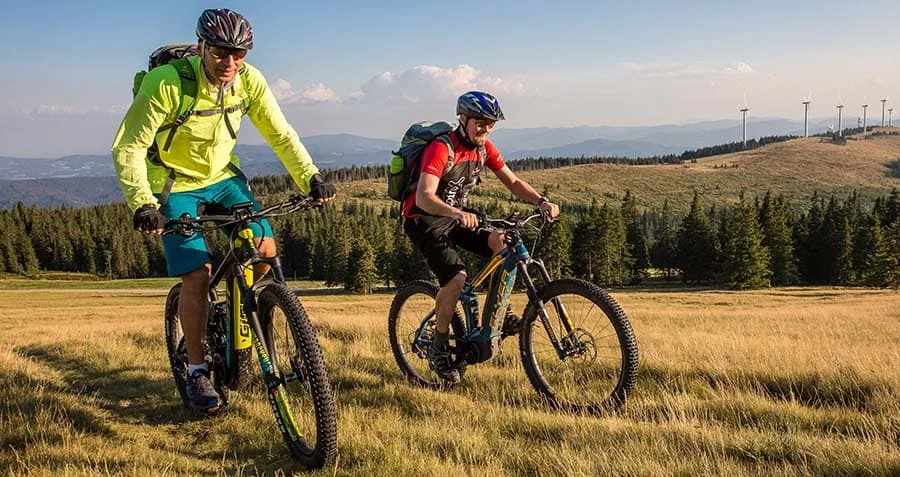Mountain biking has long been a popular way to explore challenging trails, stay fit, and enjoy the great outdoors. But over the past few years, a new category of bikes has exploded onto the scene and changed the game: electric mountain bikes (eMTBs). These pedal-assist bicycles blend human power with an electric motor, making steep climbs and long rides more accessible to a broader range of riders.
Yet, as with any significant purchase, choosing the right eMTB can be daunting. A host of technical terms—motor torque, battery watt-hours, suspension travel, and more—can overwhelm even seasoned cyclists. This in-depth guide will walk you through the essentials you need to know before buying an electric mountain bike, ensuring you pick a model that suits your riding style, local terrain, and budget.
1. Why Choose an Electric Mountain Bike?
a) Tackling Steep Climbs and Longer Distances
One of the primary appeals of an electric mountain bike is pedal assistance. The bike’s motor boosts your pedaling power, making steep climbs more manageable and expanding the range you can cover in a single outing. You can explore further and ride longer without the same level of fatigue experienced on a standard mountain bike. This is particularly beneficial if you:
- Live in an area with steep, mountainous terrain
- Enjoy backcountry exploration and want to access remote trails
- Are a beginner or returning rider looking to build fitness gradually
b) Leveling the Playing Field
eMTBs can also make group rides more inclusive. If you’re an intermediate rider who struggles to keep pace with advanced friends, a pedal-assist bike helps you stay with the pack. Conversely, if you’re a strong rider but want to ride with less-experienced companions, the eMTB lets them keep up without drastically limiting your own workout.
c) Encouraging More Frequent Riding
The extra support and fun factor can encourage you to hop on the bike more often. Many owners find that the eMTB experience rekindles their enthusiasm for cycling, thanks to the excitement of faster acceleration, the ability to maintain momentum through tough sections, and the confidence to tackle new terrain.

2. Understanding Motor Types and Placement
An eMTB’s motor is the heart of the bike’s power-assist system. The two primary placement options are hub-drive and mid-drive motors, each with its own strengths and weaknesses.
a) Hub-Drive Motors
Situated in the rear wheel’s hub, these motors are more common in lower-cost or commuter-style electric bikes. While you can find some hub-drive eMTBs, they’re less common in the performance segment for a few reasons:
- Pros: Simple design, often more affordable; minimal drivetrain wear because the motor power is applied directly to the wheel.
- Cons: Heavier rear wheel, can impact balance and traction on technical climbs; less efficient in steep off-road conditions; torque typically lower compared to mid-drive systems.
b) Mid-Drive Motors
These motors sit centrally in the frame, near the bottom bracket, and drive the chainring. Mid-drive systems dominate the performance eMTB market due to their superior torque and balance:
- Pros: Better weight distribution (low and center), improved handling on rough terrain, high torque for steep climbs, synergy with bike’s gears for efficient power delivery.
- Cons: More expensive, increased drivetrain wear because added torque goes through the chain and gears.
c) Motor Brands and Performance
Several major players dominate the eMTB motor market: Bosch, Shimano Steps, Brose, Yamaha, and Fazua among others. Each brand produces various models differing in torque and programming “feel.” The peak torque (measured in Newton meters, or Nm) ranges from around 50 Nm in lighter, more discreet systems to over 90 Nm in robust motors designed for high-performance climbing.
If you frequently tackle extremely steep or technical climbs, a higher torque motor (around 70-90 Nm) can be beneficial. More moderate trails or riders seeking a natural pedaling feel may prefer motors with less extreme torque output.
3. Battery Capacity, Range, and Charging
a) Battery Capacity and Watt-Hours (Wh)
An electric bike’s battery capacity is typically stated in watt-hours (Wh), which reflect how much energy is stored. The higher the watt-hour rating, the more potential range you can enjoy. Many eMTBs offer batteries in the 400–750 Wh range, although some premium models exceed 900 Wh:
- 400–500 Wh: Common in older or entry-level models; suitable for shorter rides (1–3 hours of assistance).
- 500–700 Wh: A sweet spot for all-around riders, providing enough capacity for a solid half-day or more of riding on moderate settings.
- 700+ Wh: For those who want extended range or plan on marathon off-road adventures. The downside is increased weight.
b) Real-World Range Factors
While battery capacity gives an approximate idea of range, real-world mileage can vary significantly based on:
- Assist level: Higher assist consumes more battery.
- Rider weight and pedaling input: Heavier riders or those providing minimal pedal effort will reduce range.
- Terrain: Steep, technical climbs drain the battery faster than flat roads.
- Weather conditions: Extreme cold can temporarily reduce battery performance.
- Tire pressure, tread pattern, and general bike maintenance can also have smaller effects.
Expect to see anywhere from 20 to 50+ miles per charge, depending on your riding style and battery size. Using eco or low-assist modes stretches range, while boost or turbo modes shorten it.
c) Charging Time
A standard charger can take 3–7 hours to fully recharge a depleted eMTB battery, depending on capacity. Some manufacturers offer faster chargers that reduce waiting time. Also consider where you’ll store and charge the bike—many batteries can be removed to charge indoors, which is especially useful in cold climates or if you don’t have a power outlet near your bike storage area.

4. Frame Designs: Hardtail vs. Full Suspension
eMTBs mirror standard mountain bikes in frame geometry, material (aluminum, carbon, or steel), and suspension design. You’ll generally encounter hardtail or full suspension electric MTB options:
a) Hardtail eMTBs
A hardtail eMTB has a suspension fork in the front and a rigid rear end. They can be an excellent budget-friendly or entry-level option:
- Pros:
- Lighter weight compared to full-suspension bikes
- Lower maintenance costs (no rear shock linkages)
- Affordable price point
- Cons:
- Less traction and comfort on rough terrain
- Can be jarring on technical trails, especially at higher eMTB speeds
Hardtails can be great for smooth singletrack, gravel roads, or cross-country rides where you don’t need significant rear suspension.
b) Full-Suspension eMTBs
Full-suspension frames incorporate a rear shock and linkages, improving comfort, traction, and control on technical terrain. This is the dominant choice for riders seeking:
- More confidence on rocky descents and tricky climbs
- The ability to handle aggressive or enduro-style terrain
- Better overall stability at higher speeds, which e-bikes can often reach more easily
Drawbacks of full-suspension eMTBs include higher cost, added weight (though the motor helps offset this), and additional maintenance for pivots and the rear shock.
5. Suspension Travel and Components
Mountain bikes vary in suspension travel, typically measured in millimeters. Travel indicates how much the fork and/or shock can compress to absorb impacts. Common categories include:
- Cross-Country / Trail (100–130 mm): Lightweight, agile, and efficient climbers. Suitable for moderate terrain and less aggressive riding styles.
- Trail / All-Mountain (130–160 mm): A versatile middle ground, handling a wide range of trails, from climbing to technical descents.
- Enduro / Downhill (160–180+ mm): Designed for big mountain riding, drops, and sustained descents. Heavier yet extremely capable.
For eMTBs, trail or all-mountain bikes (130–160 mm travel) are quite popular, offering enough suspension to smooth out rough trails without being unwieldy. Your local terrain, riding style, and preference for climbing efficiency vs. downhill performance will guide your choice.
6. Weight and Handling
It’s no secret that electric mountain bikes are heavier than their traditional counterparts, largely due to the motor, battery, and reinforced frames. Typical eMTB weights range from about 40 to 60 pounds (18 to 27 kg) or more. While the motor helps offset extra pounds on climbs, the added mass can affect:
- Handling: The bike may feel more stable in some scenarios due to the lower center of gravity but can be less nimble in tight corners or when maneuvering at slow speeds.
- Transport: Lifting the bike onto a car rack, or lugging it up stairs, can be more challenging. Ensure your rack is rated for heavier e-bikes if you frequently drive to trailheads.
- Battery Efficiency: Heavier bikes may sap battery life faster, although motor torque helps compensate.
Modern designs and materials aim to keep weight manageable while retaining structural integrity. If you plan a lot of hike-a-bike segments or very technical maneuvers, look for a lighter eMTB or one with well-balanced geometry.

7. Tire Choice and Wheel Size
Traction is critical in off-road riding, and electric MTB riders often appreciate grippier setups that handle high torque demands. Plus-size tires (2.6 to 3.0 inches wide) remain common on many eMTBs for improved traction and stability. Meanwhile, standard 2.3 to 2.5-inch tires are also used on trail and enduro models, balancing grip with rolling efficiency.
Wheel sizes vary:
- 27.5-inch wheels offer agility and quick handling, particularly suitable for smaller riders or tight, twisty trails.
- 29-inch wheels roll over obstacles more easily, providing stability and maintaining momentum—often favored for more open and faster terrain.
- Mixed or “Mullet” setups (29-inch front, 27.5-inch rear) have become popular for combining the rollover benefits of a 29er front with the flickability of a smaller rear wheel.
Ultimately, tire and wheel size preferences come down to personal riding style and local trail conditions. eMTBs sometimes come stock with robust double-down or e-specific casings to withstand the extra torque and weight.
8. Braking Power and Drivetrain
Because eMTBs can accelerate quickly and maintain higher speeds, powerful braking is essential. Look for:
- Hydraulic disc brakes with larger rotors (180–220 mm), providing consistent stopping power and heat dissipation.
- Branded brake systems from Shimano, SRAM, Magura, or TRP typically offer robust performance.
On the drivetrain side:
- Most modern eMTBs run 1x (single chainring) setups with wide-range cassettes, like 11-speed or 12-speed, simplifying shifting and providing enough range for both steep climbs and fast descents.
- Heavy-duty chains and cassettes may be used to cope with the increased torque demands.
- Mid-drive motors integrate with your bike’s drivetrain, so ensuring you shift smoothly and maintain the chain can prevent wear and tear.
9. Electronics and Display Features
Most electric mountain bikes come with a handlebar-mounted display or control unit, allowing you to cycle through assist levels, check battery life, and track metrics like speed or distance. Some advanced systems connect to a smartphone app for ride data, route planning, or firmware updates. Key points to consider:
- Assist Modes: Typically range from Eco/Low to Turbo/Boost. More modes provide fine-tuned power management.
- Walk Assist: A low-speed mode to help push the bike uphill, useful for hike-a-bike sections.
- Ergonomics: Control buttons should be easy to reach and use without distracting from the ride.
Also, check if the motor’s software is customizable, allowing you to adjust torque curves or responsiveness. Some brands let you tweak these settings via an app, tailoring the ride feel to your preferences.
10. Local Regulations and Trail Access
Electric mountain bikes fall under various classifications (Class 1, 2, or 3 in the U.S., for instance) or regional rules worldwide. Regulations can restrict:
- Motor power and top assisted speed (e.g., 250W with pedal assistance up to 20 mph/25 kph in some areas).
- Where eMTBs are allowed: Some trails treat Class 1 pedal-assist e-bikes as standard bicycles, while others ban them, citing concerns about trail erosion or user conflicts.
Before buying an eMTB, research local laws and trail guidelines. Some U.S. states require eMTBs only on motorized or specifically e-bike-approved routes. Many regions, however, are gradually adopting more eMTB-friendly policies—especially for Class 1 models.

11. Maintenance and Reliability
All bicycles require routine upkeep, but eMTBs have a few extra considerations:
- Motor and Battery Care:
- Keep the battery within recommended temperature ranges. Avoid prolonged exposure to extreme heat or cold.
- Clean the bike carefully around the motor; never fully submerge electronic components in water.
- Check if your local shop is certified to service that motor brand.
- Drivetrain Wear: The added torque can accelerate wear on chains, cassettes, and chainrings. Regular inspections are crucial.
- Suspension and Brakes: Heavier eMTBs can stress suspension seals and brake pads. Service them according to manufacturer intervals.
When purchasing, consider the availability of spare parts and whether you have access to a shop experienced in eMTB repairs. A reputable brand with a strong support network can simplify maintenance and warranty claims.
12. Fitting and Test Rides
Like any mountain bike, fit is critical for comfort and control:
- Frame Sizing: Each brand has geometry charts covering reach, stack, and seat tube lengths. Compare these with your height, inseam, and riding preferences.
- Cockpit Setup: Bars, stem length, and saddle choice can be adjusted. When possible, test ride multiple bikes or consult an experienced fitter.
- Demo Rides: If there’s a local event or shop offering demos, seize the chance to experience how different eMTB setups feel on real trails. This is often the best way to sense if the motor’s character, geometry, and suspension suit you.
13. Budget Considerations
eMTBs generally cost more than traditional mountain bikes due to motor and battery technology, stronger frames, and specialized components. Prices typically range from around $2,500 for entry-level hardtails to $6,000+ for premium full-suspension models with advanced motors and high-end components. Carbon fiber frames can push the price even higher.
What Affects Price?
- Battery size: Larger capacity batteries cost more.
- Motor brand/model: Higher torque, advanced drive units are pricier.
- Suspension quality: Fox or RockShox top-tier suspension significantly elevates costs.
- Drivetrain/brakes: Higher-tier groupsets from Shimano or SRAM also command higher prices.
It’s wise to determine your maximum budget, then look for the best combination of motor performance, frame design, and component quality within that range.
14. Accessories and Gear
Once you have your eMTB, you’ll likely consider a few accessories to enhance safety and convenience:
- Helmet: Choose a high-quality mountain biking helmet with good coverage. Consider a full-face model if you ride aggressive trails.
- Protective Gear: Knee and elbow pads, or body armor if you’re tackling enduro/downhill terrain.
- Lights: If riding in dim conditions or if local laws require front/rear lights.
- Tool Kit and Spare Tube: Flats still happen, and eMTBs often run tubeless setups but carry a spare tube just in case.
- Cargo Solutions: Frame bags or smaller backpacks for water, tools, and snacks.
- Car Rack: Verify your rack is rated for heavier eMTBs if transporting them by vehicle.

15. Final Thoughts: Choose Wisely, Ride Confidently
Electric mountain bikes open doors to new adventures, letting you conquer hills that once seemed impossible and explore remote trails with renewed energy. However, selecting the right eMTB requires understanding motor types, battery capacity, suspension travel, and local regulations. Balancing these considerations against your riding style, fitness goals, and budget ensures that you invest in a bike that will serve you well.
Above all, eMTBs should amplify the joy you already find in cycling—extending your range, offering smoother climbs, and delivering plenty of smiles on each descent. By considering the insights in this guide, you’ll be equipped to make an informed decision and start your eMTB journey on the right foot. Soon enough, you’ll be scaling new heights and savoring epic, pedal-assisted adventures in the great outdoors.
Happy trails—and enjoy the ride!
